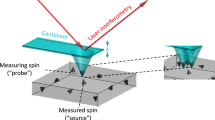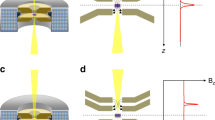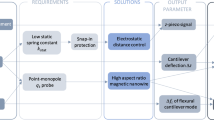Abstract
Today's magnetic-field sensors1 are not capable of making measurements with both high spatial resolution and good field sensitivity. For example, magnetic force microscopy2 allows the investigation of magnetic structures with a spatial resolution in the nanometre range, but with low sensitivity, whereas SQUIDs3 and atomic magnetometers4 enable extremely sensitive magnetic-field measurements to be made, but at low resolution. Here we use one-dimensional Bose–Einstein condensates in a microscopic field-imaging technique that combines high spatial resolution (within 3 micrometres) with high field sensitivity (300 picotesla).
Similar content being viewed by others
Main
Trapped cold atoms are ideal magnetic sensors as they are very sensitive to changes in magnetic-field landscapes, even in the presence of large homogeneous offset fields. Density modulations in trapped thermal atomic clouds have already been used as a measure of magnetic field variation caused by irregular current flow in nearby conductors5,6,7,8. We have produced a versatile, high-resolution sensor based on Bose–Einstein condensates (BECs). Its sensitivity is not limited by the temperature T of the cloud, but is rather determined by the chemical potential µ of the condensate, which can be orders of magnitude lower than kBT (where kB is Boltzmann's constant).
The principles of the technique are shown in Fig. 1a. A BEC is trapped at the measurement site so that its density profile can be directly imaged. The spatially varying density is a measure of the potential energy and hence of the local magnetic-field variation. To probe spatial magnetic-field variations, we start by confining a one-dimensional BEC (in which µ is smaller than an energy quantum of transverse excitation)9 in an elongated magnetic micro-trap with strong transverse and weak longitudinal confinement, created by small conductors mounted on the surface of an atom chip10.
a, Experimental set-up. A Bose–Einstein condensate is created and trapped by a current-carrying wire mounted on a silicon surface (atom chip) and is positioned above the sample to be probed. b, Two-dimensional scan of the magnetic landscape (field component along the wire direction) above a 100-µm-wide and 3.1-µm-tall gold wire. This profile has been reconstructed from 28 equally spaced one-dimensional atomic-density traces measured 10 µm above the current-carrying wire at a homogeneous offset field of 2 millitesla, so that relative field variations of only 4 p.p.m. stemming from slightly irregular current flow could be measured at a spatial resolution of 3 µm.
As a demonstration, we measured the magnetic-field variations above the 100-µm-wide current-carrying wire used to create the trap itself. Scanning the position of the BEC enabled us to reconstruct a full two-dimensional magnetic-field profile (Fig. 1b) near the wire with unprecedented accuracy (sensitivity of 4 nanotesla) at the measurement resolution (3 µm). From this map, we reconstructed the local current flow in the wire11 and found extremely small angular deviations (2×10−4 root-mean-square radians) from a straight current path (for details, see supplementary information).
We also investigated an independent field landscape by placing a BEC close (5 µm) to a test wire structure. As long as this structure is grounded and carries no current, the atomic-density profile is homogeneous within the detection sensitivity. This corresponds to an upper bound in potential roughness of less than 10−14 eV, corresponding to a temperature of 200 picokelvin (field sensitivity of 300 picotesla). As soon as a small current (about 5 mA) is passed through the wire, a characteristic field profile is imaged.
The technique is applicable not only to magnetic fields, but can also be used to detect variations in electrostatic fields, as can be shown by charging the probed structure electrically. This measurement is more sensitive than the one discussed above because the trapping parameters can be adjusted independently from the measured potential landscape by using a separate wire for holding the BEC.
The optimal potential sensitivity of a BEC used as a field sensor, ΔB=γΔN/z03, is achieved if the trapping parameters are adjusted so that the cloud's transverse size matches the desired spatial resolution z0. Here ΔN is the minimal atom-number variation resolved by the imaging system, and γ contains all the atomic-physics parameters of the specific atom (γ=8.63×10−29 tesla cubic metres for the 87Rb used in our experiment). Currently available CCD (charge-coupled device) cameras allow atom-shot noise-limited detection with a ΔN value of better than 10 atoms per pixel in absorption imaging, so that a sensitivity, ΔB, of 1 nanotesla is possible even at a high spatial resolution of 1 µm (or 1 picotesla at 10 µm). By changing to a different atom with higher mass and/or by reducing the interatomic interaction, a significant increase in sensitivity can be achieved.
A comparison of different magnetic-field measurement techniques1,2,3,4,12 (see supplementary information) shows that BECs as magnetic sensors could reach unprecedented sensitivity over a large range of spatial resolution. The sample measurements we present here reach higher sensitivities than those obtained with established techniques operating at the same spatial resolution.
References
Bending, S. J. Adv. Phys. 48, 499–535 (1999).
Freeman, M. R. & Choi, B. C. Science 294, 1484–1488 (2001).
Faley, M. I. et al. Supercond. Sci. Technol. 17, 324–327 (2004).
Kominis, I. K., Kornack, T. W., Allred, J. C. & Romalis, M. V. Nature 422, 596–599 (2003).
Fortagh, J., Ott, H., Kraft, S., Günther, A. & Zimmermann, C. Phys. Rev. A 66, 041604 (2002).
Esteve, J. et al. Phys. Rev. A 70, 043629 (2004).
Leanhardt, A. E. et al. Phys. Rev. Lett. 89, 040401 (2002).
Jones, M. P. A. et al. Phys. Rev. Lett. 91, 080401 (2003).
Dunjko, V., Lorent, V. & Olshanii, M. Phys. Rev. Lett. 86, 5413–5416 (2001).
Folman, R., Krüger, P., Schmiedmayer, J., Denschlag, J. & Henkel, C. Adv. At. Mol. Opt. Phys. 48, 263–356 (2002).
Rous, P. J., Yongsunthon, R., Stanishevsky, A. & Williams, E. D. J. Appl. Phys. 95, 2477–2486 (2004).
Oral, A. et al. IEEE Trans. Magn. 38, 2438–2440 (2002).
Author information
Authors and Affiliations
Corresponding author
Ethics declarations
Competing interests
The authors declare no competing financial interests.
Rights and permissions
About this article
Cite this article
Wildermuth, S., Hofferberth, S., Lesanovsky, I. et al. Microscopic magnetic-field imaging. Nature 435, 440 (2005). https://doi.org/10.1038/435440a
Published:
Issue Date:
DOI: https://doi.org/10.1038/435440a
This article is cited by
-
Cooking with quantum gas
Nature Physics (2020)
-
Retroreflection and diffraction of a Bose–Einstein condensate by evanescent standing wave potential
Scientific Reports (2020)
-
High-sensitivity magnetometry with a single atom in a superposition of two circular Rydberg states
Nature Physics (2019)
-
Quantum-enhanced sensing using non-classical spin states of a highly magnetic atom
Nature Communications (2018)
-
Ultrasensitive magnetic field detection using a single artificial atom
Nature Communications (2012)
Comments
By submitting a comment you agree to abide by our Terms and Community Guidelines. If you find something abusive or that does not comply with our terms or guidelines please flag it as inappropriate.




